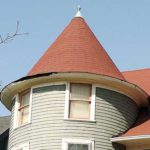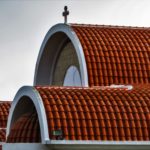The domed roof, like the cone-shaped one, has a circle at its base. The top of the structure becomes the central point where the legs of the rafters converge. The house with a high round roof attracts attention with its intricacy.
Dome roof history
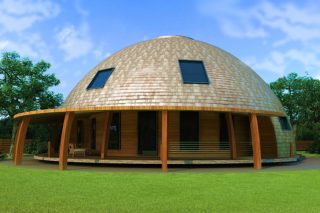
Constructions in the form of a hemisphere or a cone were widely used by ancient Russian architects. They are typical for towers, estates, churches and outbuildings. Often, a round roof covered the porch and other small architectural elements of the building.
In the past, cone-shaped roofs were common in parts of Italy. They were mounted on block houses; reeds or straw were used for the roof. Now the use of such structures in private homes is not very common due to the greater difficulty of work compared to the arrangement of a gable roof.
Such a design of the roof will make the appearance of the house more memorable and expressive. It is especially suitable for areas where historical buildings have been preserved.
Design features
The round roof is attractive not only for its decorative qualities. From the functional point of view, this option is quite practical, as it ensures timely water drainage. The support of the domed roof structure is its base, made in the form of a circle. The legs of the rafters are fixed on it. When joining a wall that is a long horizontal plane, the base should be semicircular.
There are also certain requirements for coverage. Sheet inflexible materials such as corrugated board will not work for her. The coating should be flexible, but not too soft. Only in this case the structure will be airtight enough and will last a long time. Flexible types of shingles are used, including bituminous and some of ceramic, as well as polycarbonate.
The most difficult knot to install is the upper convergence point of the rafters.
Varieties of domed roof
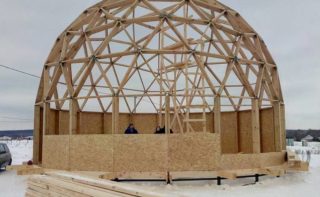
There are several options for the execution of roof structures with a round base. They differ in appearance and structural features.
Geodetic
Such a spherical roof appeared in the middle of the last century in the United States. Its feature is the absence of the usual rafter system. The configuration is formed by equilateral triangular parts made of meter-long bars with a cross section of 5 by 10 cm. For connection, a 10 cm steel connector tube is used, to which the blades are attached by welding in pairs. The result is a star-shaped structure with 5 or 6 beams. Sometimes triangles are combined without connectors.
Arched
This design bears more resemblance to the familiar sloped roof. The rafters for her are deliberately made curved.
You can buy ready-made wooden or metal elements or make them yourself from a bar.
Conical
A cone roof can be an independent structure or a component of a composite roof. It is important that the base under it has the shape of a circle. The legs of the rafters in this case should be straight. The conical structure diagram does not include such familiar elements as pediments and ridge. The roof must have a sufficient slope angle (minimum 15 degrees).
To improve the bearing capacity, support rack elements are mounted under the rafters, abutting against the floor beams.
Roof frame device
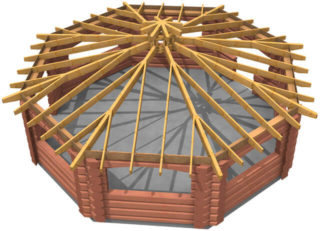
In the place where the dome is installed, a Mauerlat is laid in the shape of a circle, which distributes the mass of the structure. Other components are:
- Ties on opposite sides to make the frame stronger.
- Spherical truss system. It can also have straight legs (as in the case of a cone), it all depends on the chosen design. The lower sections are fixed on the Mauerlat, and the upper ones, connecting at the highest point, form the ridge knot.
- Rack-vertical, into which the upper rafter elements are inserted.
Another component is the lathing, which is fixed at right angles to the legs. They make it from rails, use self-tapping screws as fasteners.
Advantages and disadvantages
From the point of view of operational characteristics, the dome roof is good in that water and snow masses come off the surface easily and in a timely manner. Due to this, the load on the structure is reduced, the material is not damaged by moisture. The ceiling in the under-roof space is usually high, which will allow for more efficient use of the space.
The downside is the impossibility of installing windows (they would create an additional load and reduce the tightness), therefore, it is impossible to equip an attic under the dome. It is more difficult to mount such a roof than a gable.
A domed roof can be installed on a circular or square base. It will not work on a rectangular building. If the house has a complex configuration, you can create an ensemble that combines round and pitched elements. A roof structure made of heavy materials must not be mounted on a light frame building.
Installation features
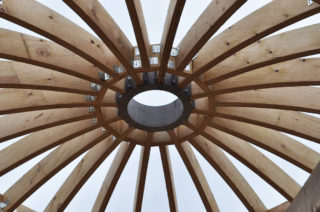
In the role of rafters, beams made of glued beams (curved or straight, depending on the design) are used. All used wooden building materials must be treated with antiseptic, fire retardant and anti-decay compounds.
If the work is carried out in a wooden house, you can do without laying the Mauerlat. In other cases, it is required. Fasten it over the roofing material insulation. The dimensions of the used timber are given in the project. Fixation is done with anchors. Then the support post is mounted. The rafters are placed in increments of 0.5-0.9 m. They are connected to the base and the rack run by means of construction corners.
Roofing cake can be made warm or cold. Do not forget about the waterproofing layer.

